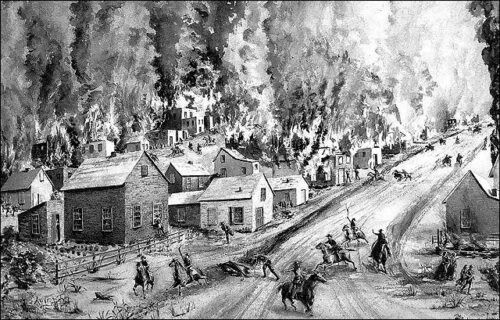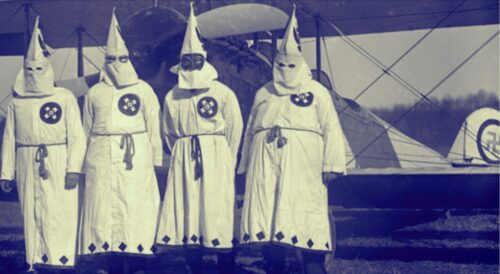Technology always intersects with human rights, whether the usual technologist recognizes it or not. An abolitionist network in the 1800s defied unjust laws to free enslaved people, and today technologists are drawing explicit parallels to this tradition. We’re witnessing an evolution toward a modern Digital Underground Railroad as citizens resist what they see as Trump’s systematic human rights violations.
Imagine being stopped, having rifles pointed at your head, being harassed or detained simply because a computer system tagged you as suspicious based on the color of your hat at dawn or the car you drove.
Consider the example of Quantrill’s Raiders, who were masked armed men without uniforms similar to the “enforcers” showing up in communities today. They terrorized America in the 1860s through brutal mob acts like the Lawrence Massacre. Critics rightly compare immigration enforcement raids of Trump to these historical patterns of militant violence adjacent to state-sanctioned oppression based on race.

The parallels connect past and present systems, exploited by white supremacist groups for them to operate outside judicial oversight, which leaves technologists at a crucial fork in the road that has been seen before.
I’m not even going to explain why President “America First” Wilson similarly sent federal troops in 1919 to open fire on Black farm workers in Arkansas, murdering hundreds after they organized in a Church to discuss fair wages. And that’s to say nothing of airplanes used in 1921 to firebomb Black neighborhoods in Oklahoma, while firefighters and police stood by doing nothing. Americans should know these past events well already, or at least be able to recognize the symbolism of the X within KKK and Nazi history.

While examining historical parallels and wondering where the Quantrill Raids go next, read Confederate General McCulloch complaints about the escalating civilian mistreatment by armed white supremacist mobs that expanded even under his militant command attempting to restrain them:
Civilians were accosted, homes were broken into, church steeples were shot up, and a Confederate recruiting officer, Major George N. Butts, was found shot to death on the side of a road. “They regard the life of a man less than you would that of a sheep-killing dog,” said McCulloch.
These descriptions invite reflection on modern law enforcement approaches, especially how anti-immigrant militant leaders planning systemic armed actions against American communities, may be unable to prevent their own troops devolving into total chaos, which is what the legendary patriot John Brown had warned until he was hanged for taking a stand against the violence.

Remember the symbolism of the X? Historical context gives perspective to the recent action against GlobalX Air, where technologists identifying with Anonymous accessed flight manifests and records of an ICE charter airline.

Anonymous said their “data liberation” operation targeted specific flights that were central to ongoing litigation, including deportation flights that allegedly were rushed to depart. Why were flights in a rush? The Trump regime saw this as their way to “hack” the courts, exploit a loophole to undermine lawyers who were in process of defending national security.
A digital version of the famous General Tubman thus justified entry into the GlobalX systems as simply “enforcing a judge’s order,” positioning the patriotic act as upholding American law rather than violating it. “Anonymous has decided to enforce the Judge’s order since you and your sycophant staff ignore lawful orders that go against your fascist plans,” read the message on GlobalX’s updated website.
A U.S. judge had indeed ordered a report of flight manifests and records. And suddenly the Trump regime decided it was no longer able to be in a rush. The Anonymous disclosure, therefore serving that judge in a more timely fashion, provides records of GlobalX from January through May. It delivers clear evidence of systematic removal of many innocent people from American soil; indiscriminate Quantrill-like raids by plain-clothed masked militants targeting non-white communities for racist incarceration or death.
Making America Grotesque Again
The immigration enforcement under the current administration has been characterized by critics as operating with questionable legal authority, particularly when deportations proceed despite pending legal challenges. This creates a complex ethical terrain where some view digital intervention to serve the law as a necessary response to what they perceive as systematic circumvention of legal processes.
We must ask: Who here really operates outside the law?
The GlobalX Air files accessed do indeed document flights central to a Supreme Court case involving Venezuelan asylum seekers who were reportedly removed from the country in direct and intentional opposition to the law. The timing of such a “hack” by the Trump regime brings profound questions about their relationship to enforcement actions designed to exploit vulnerabilities in judicial oversight.
Conducting a Digital Freedom Railroad
In comparison, an emerging pattern of digital resistance to Trump draws directly from American traditions of civil action to enhance law and order and restore moral foundations. Those who engage in these actions rightfully invoke historical figures like General Tubman because they fit within a lineage of Americans who aligned defense of law and order in America to its underlying documented principles (e.g. Constitution).
The digital actions countering unlawful deportations are information exposure rather than system interruption, unlike the Trump regime’s aggressive and destructive actions. Like whistleblowers, they direct information to sunlight, creating accountability channels outside compromised structures.
Constitutional Disregard is a Trump Family Tradition
When executive actions appear to intentionally and cruelly “hack” judicial review, fundamental constitutional questions emerge. The intervention in GlobalX Air systems to deliver justice presents a complex case study in the tensions between executive enforcement power, judicial authority, and citizen intervention.
Throughout American history, from abolitionism to civil rights movements, significant moral progress has often begun with acts of civil action to serve the greater meaning of law and order. Today’s digital actions represent the latest chapter in this ongoing negotiation between law, justice, and resistance.
As we evaluate these events, we confront profound questions about democratic processes: When formal systems of checks and balances are under attack by white supremacist groups aiming to imbalance power for selfish gains, what responsibilities do citizens have? At what point does resistance to attacks on America become not just justified but necessary to restore the balance of power and prevent tyranny?
What Would LaGuardia Do?
Speaking of airlines and airports, let’s take a moment to think about LaGuardia, mayor of New York during the rise of fascism in Europe. He was well-known as a warrior of direct and uncompromising stance against authoritarianism. He understood that certain moments in history require clear moral language rather than cautious equivocation. In 1937, for example, he directly called out fascism by name and denounced dictators like Hitler and Mussolini when many American politicians were still hesitant to do so. This wasn’t just a foreign concern, but more importantly a domestic one where America First campaigns were correctly ruled an act of sedition.

We’re at a similar inflection point regarding immigration enforcement and civil liberties. When LaGuardia saw the early signs of authoritarianism, he recognized the urgent need to speak plainly about the threats he perceived, rather than softening his language out of political convenience.

Acts of resistance against extrajudicial deportations are within this tradition of urgent moral action. The Underground Railroad and abolitionists, from John Brown to General Tubman, inform Americans how direct action can effect change where formal systems have been compromised and redirected towards harm of vulnerable populations.
